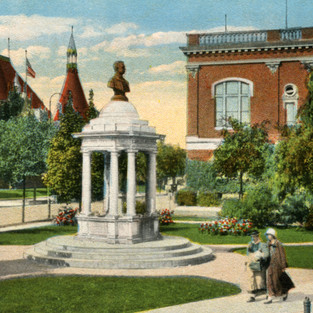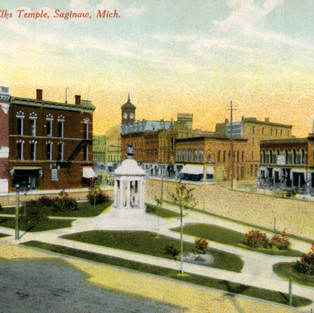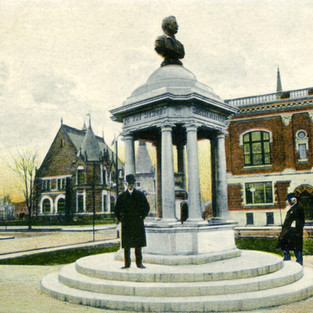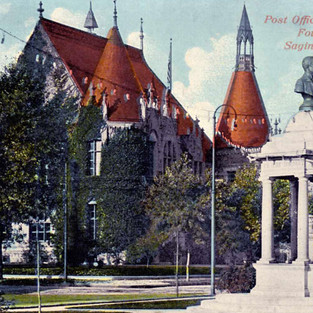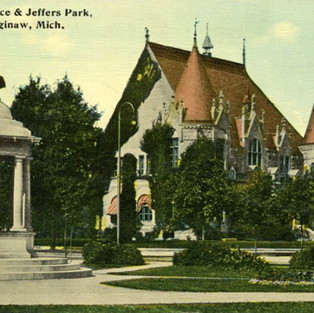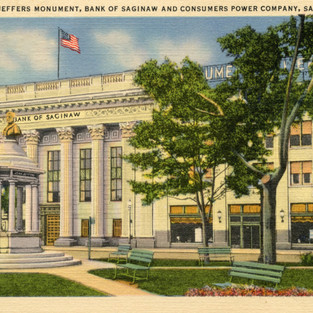
Located east of the Castle Museum on a small triangular parcel of land bound by East Genesee, Federal and Warren, Jeffers Park and a memorial fountain were dedicated with great fanfare on May 30, 1906 and have been a focal point of the business district since that date. The space has served as a town square and as a downtown meeting spot. The land for the park and the fountain were donated to the community in honor of Michael Jeffers by his brother, John Jeffers, and his niece, Elizabeth Champe.
When he passed away, Michael Jeffers was described in the Detroit Free Press as being one of the “early pioneers of Saginaw” and a headline in The Saginaw Courier Herald proclaimed that “His Death Removes Another of the Devoted Band who Laid the Foundations of the City of Today.” Born in Ireland in 1831, Jeffers and his family immigrated to the United States when he was seven. He moved to the city of East Saginaw in 1853, before the city was officially chartered. Upon his arrival in East Saginaw, he started to acquire commercial properties. As East Saginaw boomed as the lumber capital of the world, the value and number of his real estate holdings increased greatly in value. At the time of his death, newspapers estimated the value of his property at almost $1,000,000. Although final accounting would show that the value of his property was considerably less, he was one of the major commercial property owners in Saginaw. He was noted for his conservative management techniques and reluctance to replace older, outmoded buildings. He served in several public positions. These included being elected as an alderman and managing bounty funds during the Civil War. He was noted for living a quiet, reserved life.
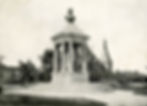
When his heirs donated the site for Jeffers Park to the City of Saginaw, the property was completely covered by commercial buildings. Saginaw was a densely constructed city and the idea of creating a park in the business district was greeted with enthusiasm.
“Of all the parks that Saginaw has or may have, none will be as centrally located as is Jeffers Park. It will be a beauty spot in the heart of the business district, and hence doubly attractive to the eye. The advantages of small parks like this, scattered throughout the city, cannot be overestimated. They are restful to the eye tired of piles of brick and mortar, and give the passer a glimpse of nature that is invigorating and elevating, and a breathing spot in the hot days of summer.”
The original plat for the city of East Saginaw did not reserve space for a public square or park. By the late 19th century, Saginaw had become Michigan’s third largest city. Attempts were made to address the shortcomings of its original planning. Adjacent to the Post Office Building, dedicated in 1898, Jeffers Park was an important early effort to address the need for public space in the business districts.
Almost immediately after accepting the gift, the city commissioned “E.C. Foster of Kalamazoo, the well-known landscape artist” to prepare “a plan for the beautifying of Jeffers Park”. Foster’s plan was centered on a public speaking platform or fountain. After the plan was developed, the Jeffers family decided to donate a monument commemorating Michael Jeffers. A committee was established that settled on the idea of a public drinking fountain placed in the center of the park. Proposals were solicited from numerous nationally prominent firms. The selected design was by Roy Merriam from Saginaw and was fabricated by the local firm of Anson Hobson. The Henry-Bonnard Bronze Company of New York made the bronze bust surmounting the structure and the bronze lion’s masks on the fountain.
Water for the fountain was supplied by a deep well that was drilled on the site and was cooled in pipes that ran through ice placed in a vault underneath the fountain. At this time, Saginaw’s water supply was taken directly from the Saginaw River. As it was considered almost undrinkable, the fountain was a popular spot for obtaining pure drinking water.
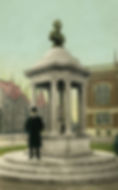
When the park and fountain were officially dedicated on May 30, 1906, the acceptance of the gift served as a focal point for the Memorial Day Parade. The parade ended in the park. The event included speeches. One of the highlights of the event was when a man ascended a ladder to place a laurel leaf wreath upon the head of the bust of Michael Jeffers. In the coverage of the event the newspaper noted, the fountain was “a work of art, a beautiful creation of architectural intellect, a constantly outstanding art lesson to this and succeeding generations…. It will last long after all those who witness the ceremonies have passed into eternity and it will remain one of the most beautiful structures in the city.”
The park and fountain have indeed lasted and served the community well. Its drinking fountain was often depicted on postcards and was a popular place of refreshment. Until the health department insisted on the installation of bubblers in 1915, individuals drank from communal tin cups placed along the ledge of the fountain.

During the Great Depression, the park accommodated a temporary demonstration home moved into the business district by the WPA. During World War II, a temporary monument to commemorate Saginaw soldiers who had died in battle was erected in the park. After the war, a marble memorial replaced the temporary monument and in 2003, this monument was relocated to another city park.
In 2003, a committee formed to preserve and restore the park and fountain. The restored park and fountain were on June 5, 2013 during Jazz on Jefferson.
(In case you didn’t recognize the significance the date of the of the original dedication: Until the passing of the national Uniform Monday Holiday act of 1968 established observance as the last Monday in May, Memorial Day – originally known as Decoration Day - was originally observed on May 30. The dedication recognized Michael Jeffers’ civic leadership during the Civil War.)


